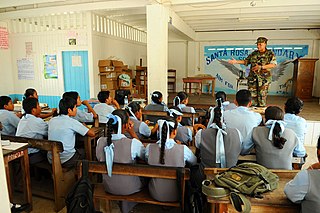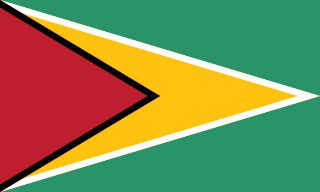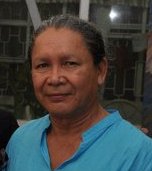Related Research Articles

Georgetown is the capital and largest city of Guyana. It is situated in Demerara-Mahaica, region 4, on the Atlantic Ocean coast, at the mouth of the Demerara River. It is nicknamed the "Garden City of the Caribbean." It is the retail, administrative, and financial services centre of the country, and the city accounts for a large portion of Guyana's GDP. The city recorded a population of 118,363 in the 2012 census.

This is a demography of Guyana including population density, ethnicity, education level, health of the populace, economic status, religious affiliations and other aspects of the population.
Guyanese culture reflects the influence of African, Indian, Amerindian, British, Portuguese, Chinese, Creole, and Dutch cultures. Guyana is part of the mainland Caribbean region. Guyanese culture shares a continuum with the cultures of islands in the West Indies.
Guyanese literature covers works including novels, poetry, plays and others written by people born or strongly-affiliated with Guyana. Formerly British Guiana, British language and style has an enduring impact on the writings from Guyana, which are done in English language and utilizing Guyanese Creole. Emigration has contributed to a large body of work relating the Guyanese diaspora experience.

Santa Rosa is a community in the Barima-Waini region of northern Guyana. Santa Rosa mission was established in 1840, and is one of the earliest Catholic Missions in Guyana. The village is part of the North West Amerindian District.

The Catholic Church in Guyana is part of the worldwide Catholic Church, under the spiritual leadership of the Pope in Rome. Bishops in Guyana are members of Antilles Episcopal Conference. Like most other nations that form the AEC, the Apostolic delegate to the bishops' conference is also the Apostolic nuncio to the country, currently American archbishop Thomas Edward Gullickson.
Campbelltown is an Amerindian village in the Potaro-Siparuni Region of Guyana, north of Mahdia. The village has been named after Stephen Campbell, the first Amerindian member of Parliament in Guyana.
Michael Arthur Gilkes was a Caribbean literary critic, dramatist, poet, filmmaker and university lecturer. He was involved in theatre for more than 40 years, as a director, actor and playwright, winning the Guyana Prize for Drama in 1992 and 2006, as well as the Guyana Prize for Best Book of Poetry in 2002. He was also respected for his insight into and writings on the work of Wilson Harris.

Guyana, officially the Co-operative Republic of Guyana, is a country on the northern coast of South America, part of the historic mainland British West Indies. Guyana is an indigenous word which means "Land of Many Waters". Georgetown is the capital of Guyana and is also the country's largest city. Guyana is bordered by the Atlantic Ocean to the north, Brazil to the south and southwest, Venezuela to the west, and Suriname to the east. With a land area of 214,969 km2 (83,000 sq mi), Guyana is the third-smallest sovereign state by area in mainland South America after Uruguay and Suriname, and is the second-least populous sovereign state in South America after Suriname; it is also one of the least densely populated countries on Earth. It has a wide variety of natural habitats and very high biodiversity. The country also hosts a part of the Amazon rainforest, the largest tropical rainforest in the world.

Carolyn Allison Rodrigues-Birkett is a Guyanese politician who was appointed Permanent Representative of Guyana to the United Nations in 2020. She previously served as Director of the Food and Agriculture Organization Liaison Office in Geneva from 2017 to 2020 and Minister of Foreign Affairs of Guyana from 2008 to 2015.

The people of Guyana, or Guyanese, come from a wide array of backgrounds and cultures including aboriginal natives, African and Indian origins, as well as a minority of Chinese and European descendant peoples. Demographics as of 2012 are Indo-Guyanese 39.8%, Afro-Guyanese 30.1%, mixed race 19.9%, Amerindian 10.5%, other 1.5%. As a result, Guyanese do not equate their nationality with race and ethnicity, but with citizenship. Although citizens make up the majority of Guyanese, there is a substantial number of Guyanese expatriates, dual citizens and descendants living worldwide, chiefly elsewhere in the Anglosphere.
Surama is an Amerindian village in the North Rupununi area and the Upper Takutu-Upper Essequibo Region of Guyana, with a population of 274 people as of 2012.

George Simon was a Guyanese Lokono Arawak artist and archaeologist. He was the founder and mentor of the Lokono Artists Group, a group of Lokono artists from Guyana, based primarily in his hometown of St. Cuthbert's Mission. Simon was widely regarded as one of the leading Guyanese artists of his generation, and his paintings are notable for their explorations of Amerindian culture and the Guyanese environment. He was also recognized for his achievements as an educator, his efforts to develop opportunities for Amerindian artists in Guyana, and for his work as an archaeologist.
Amerindian Heritage Month is an annual observance that is held every September in Guyana in honour of Guyana's indigenous peoples.
John Peter Bennett was a Guyanese priest and linguist. A Lokono, in 1949, he was the first Amerindian in Guyana to be ordained as an Anglican priest and canon. His linguistic work centred on preserving his native Arawak language and other Amerindian languages; he wrote An Arawak-English Dictionary (1989).
Oswald ("Ossie") Hussein is a Guyanese artist of Lokono (Arawak) descent. Though he occasionally works in other mediums, he is best known for his wooden sculptures, which explore various dimensions of Arawak Amerindian culture and tradition. Hussein first achieved national recognition when he won first prize in Guyana's National Exhibition of the Visual Arts in 1989, and since that time he has gone on to become one of Guyana's most celebrated artists and a leading figure in Guyanese sculpture. Along with his half-brother, George Simon, he is one of the most prominent members of the Lokono Artists Group. His work has been displayed in numerous exhibitions in Guyana, Barbados, and the United Kingdom.
St. Cuthbert's Mission is an Amerindian village on the Mahaica River in the Demerara-Mahaica region of Guyana. It comprises approximately 200 households. St. Cuthbert's is regarded by many people in Guyana as the "cultural capital" for Amerindians.

Indigenous peoples in Guyana, Native Guyanese or Amerindian Guyanese are Guyanese people who are of indigenous ancestry. They comprise approximately 9.16% of Guyana's population. Amerindians are credited with the invention of the canoe, as well as Cassava-based dishes and Guyanese pepperpot, the national dish of Guyana. Amerindian languages have also been incorporated in the lexicon of Guyanese Creole.

Yvonne Fredericks-Pearson is a Guyanese politician. She has been a member of the National Assembly since 2015. She served as Toshao of Mainstay/Whyaka from 1994 to 2012.

Santa Mission is a village in the Essequibo Islands-West Demerara Region of Guyana. Santa Mission is mainly inhabited by Lokono Amerindians. The village is located on the Kamuni Creek, a tributary of the Demerara River. The village of Hopetown, an early Chinese settlement, is located about 15 kilometres (9.3 mi) from Santa Mission.
References
- 1 2 3 Haynes, Andre (18 September 2008). "Treading on Stephen Campbell's Roads: Is the Dream Finally a Reality?". Stabroek News. Retrieved 9 July 2012.
- 1 2 3 Anon (9 September 2011). "Stephen Campbell Remembered at Evening of Reflection". Guyana Chronicle Online. Retrieved 9 July 2012.
- 1 2 3 Knews (2 September 2011). "21st Century Amerindian Heritage". Kaieteur News. Retrieved 9 July 2012.
- ↑ GINA (Guyana's Government Information Agency) (11 September 2011). "Heritage Village celebrations highlight contributions of Parliamentarian Stephen Campbell". Archived from the original on 30 May 2012. Retrieved 9 July 2012.
- 1 2 3 "Propagating the Memory of Indigenous Hero, Stephen Campbell". Guyana Chronicle. Retrieved 8 September 2020.
- 1 2 3 Anon (10 September 2010). "Amerindian Affairs Ministry pays tribute to first Amerindian Legislator, Stephen Campbell". Guyana Chronicle Online. Retrieved 9 July 2012.
- ↑ Moruca Newsletter - Santa Rosa. "Wall of Fame: Notable Morucans" . Retrieved 9 July 2012.
- ↑ "Politics…TUF's trek into history". Stabroek News. Retrieved 8 September 2020.
- 1 2 "Public building to be renamed in Stephen Campbell's honour". Department of Public Information. Retrieved 8 September 2020.
- ↑ Smock, Kirk (2008). Guyana:The Bradt Travel Guide. UK: Bradt Travel Guides. ISBN 978-1-84162-223-1.
- ↑ "Indigenous Peoples of the A-B-C countries of South America". Guyana Chronicle. Retrieved 9 September 2020.